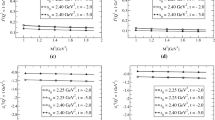Abstract
The pion charge and scalar form factors, F 1(Q 2) and F 0(Q 2) , are first calculated in different forms of relativistic quantum mechanics. This is done using the solution of a mass operator that contains both confinement and one-gluon exchange interactions. Results of calculations, based on a one-body current, are compared to experiment for the first one. As could be expected, those point form, and instant and front-form ones in a parallel momentum configuration fail to reproduce experiment. The other results corresponding to a perpendicular momentum configuration (instant form in the Breit frame and front form with q + = 0 do much better. The comparison of charge and scalar form factors shows that the spin-1/2 nature of the constituents plays an important role. Taking into account that only the last set of results represents a reasonable basis for improving the description of the charge form factor, this one is then discussed with regard to the asymptotic QCD power law behavior Q-2. The contribution of two-body currents in achieving the right power law is considered while the scalar form factor, F 0(Q 2) , is shown to have the right power law behavior in any case. The low-Q2 behavior of the charge form factor and the pion decay constant are also discussed.
Similar content being viewed by others
References
C.J. Bebek et al., Phys. Rev. D 17, 1693 (1978).
S.R. Amendolia et al., Nucl. Phys. B 277, 168 (1986).
J. Volmer et al., Phys. Rev. Lett. 86, 1713 (2001).
T. Horn et al., Phys. Rev. Lett. 97, 192001 (2006).
V. Tadevosyan et al., Phys. Rev. C 75, 055205 (2007).
G.M. Huber et al., nucl-ex/0809.3052.
C.D. Roberts, Nucl. Phys. A 605, 475 (1996).
P. Maris, C.D. Roberts, Phys. Rev. C 58, 3659 (1998).
P. Maris, P.C. Tandy, Phys. Rev. C 62, 055204 (2000).
D. Merten, et al., Eur. Phys. J. A 14, 477 (2002).
S. Simula, Phys. Rev. C 66, 035201 (2002).
B. Bakker, H.-M. Choi, C.-R. Ji, Phys. Rev. D 63, 074014 (2001).
J.P.B.C. de Melo et al., Nucl. Phys. A 707, 399 (2002).
N. Isgur, C.H. Llewellyn Smith, Phys. Rev. Lett. 52, 1080 (1984).
P.L. Chung, F. Coester, W.N. Polyzou, Phys. Lett. B 205, 545 (1988).
F. Cardarelli et al., Phys. Lett. B 332, 1 (1994).
F. Cardarelli, E. Pace, G. Salmé, S. Simula, Phys. Lett. B 357, 267 (1995).
H.-M. Choi, C.-R. Ji, Phys. Rev. D 59, 074015 (1999).
J.P.C.B. de Melo, H.W.L. Naus, T. Frederico, Phys. Rev. C 59, 2278 (1999).
T.W. Allen, W.H. Klink, Phys. Rev. C 58, 3670 (1998).
A.F. Krutov, V.E. Troitsky, Phys. Rev. C 65, 045501 (2002).
A. Amghar, B. Desplanques, L. Theußl, Phys. Lett. B 574, 201 (2003).
F. Coester, W.N. Polyzou, nucl-th/0405082.
Jun He, B. Julia-Diaz, Yu-bing Dong, Phys. Lett. B 602, 212 (2004).
Q.B. Li, D.O. Riska, Phys. Rev. C 77, 045207 (2008).
J.P.B.C. de Melo et al., Nucl. Phys. A 631, 574c (1998).
B. Bakamjian, L.H. Thomas, Phys. Rev. 92, 1300 (1953).
P.A.M. Dirac, Rev. Mod. Phys. 21, 392 (1949).
A. Amghar, B. Desplanques, L. Theußl, Nucl. Phys. A 694, 439 (2001).
A. Amghar, B. Desplanques, Few-Body Syst. 28, 65 (2000).
A. Amghar, B. Desplanques, L. Theußl, Nucl. Phys. A 714, 213 (2003).
B. Desplanques, preprint, nucl-th/0407074.
S.J. Brodsky, G.R. Farrar, Phys. Rev. D 11, 1309 (1975).
G.R. Farrar, D.R. Jackson, Phys. Rev. Lett. 43, 246 (1979).
G.P. Lepage, S.J. Brodsky, Phys. Lett. B 87, 359 (1979).
B. Desplanques, L. Theußl, Eur. Phys. J. A 13, 461 (2002).
B. Desplanques, L. Theußl, Eur. Phys. J. A 21, 93 (2004).
B. Desplanques, in NSTAR2004, edited by J.P. Bocquet, V. Kuznetsov, D. Rebreyend (World Scientific, 2005) (nucl-th/0405060).
J.L. Basdevant, S. Boukraa, Z. Phys. C 30, 103 (1986).
A. Le Youanc, L. Oliver, J.C. Raynal, J. Math. Phys. 38, 3997 (1997).
C. Alabiso, G. Schierholz, Phys. Rev. D 10, 960 (1974).
B. Desplanques, B. Silvestre-Brac, F. Cano, P. Gonzalez, S. Noguera, Few-Body Syst. 29, 169 (2000).
B. Desplanques, Nucl. Phys. A 748, 139 (2005).
B. Bakamjian, Phys. Rev. 121, 1849 (1961).
S.N. Sokolov, Theor. Math. Phys. 62, 140 (1985).
W.H. Klink, Phys. Rev. C 58, 3587 (1998).
B. Desplanques, Y.B. Dong, Eur. Phys. J. A 37, 33 (2008).
B. Desplanques, L. Theußl, S. Noguera, Phys. Rev. C 65, 038202 (2002).
A.V. Efrimov, A.V. Radyushkin, Phys. Lett. B 94, 245 (1980).
R. Tarrach, Z. Phys. C 2, 221 (1979).
S.B. Gerasimov, Yad. Fiz. 29, 513 (1979).
V. Bernard, U. Meisner, Phys. Rev. Lett. 61, 2296 (1988).
J. Carbonell, B. Desplanques, V.A. Karmanov, J.-F. Mathiot, Phys. Rep. 300, 215 (1998).
V. Braguta, W. Lucha, D. Melikhov, Phys. Lett. B 661, 354 (2008).
S. Godfrey, N. Isgur, Phys. Rev. D 32, 189 (1985).
J. Carlson, J.B. Kogut, V.R. Pandharipande, Phys. Rev. D 28, 2807 (1983).
Author information
Authors and Affiliations
Corresponding author
Additional information
Communicated by V. Vento
Rights and permissions
About this article
Cite this article
Desplanques, B. RQM description of the charge form factor of the pion and its asymptotic behavior. Eur. Phys. J. A 42, 219 (2009). https://doi.org/10.1140/epja/i2009-10864-8
Received:
Revised:
Accepted:
Published:
DOI: https://doi.org/10.1140/epja/i2009-10864-8



